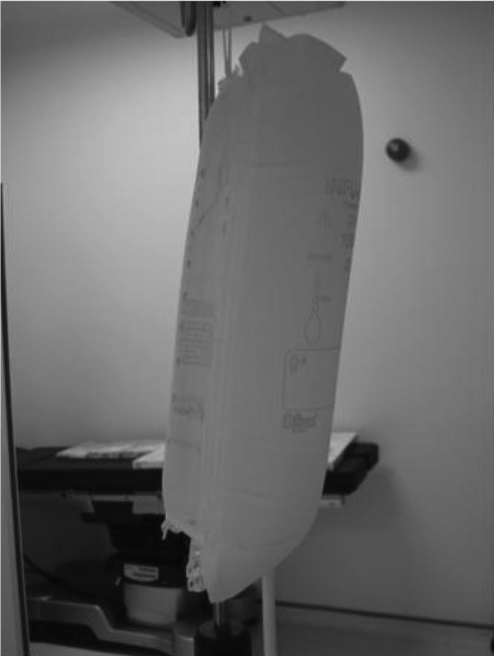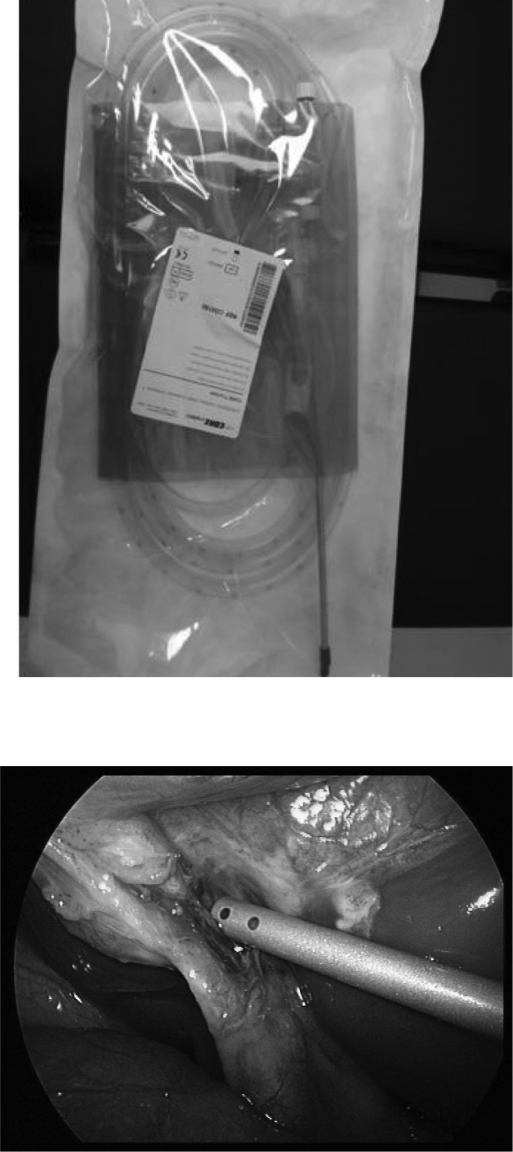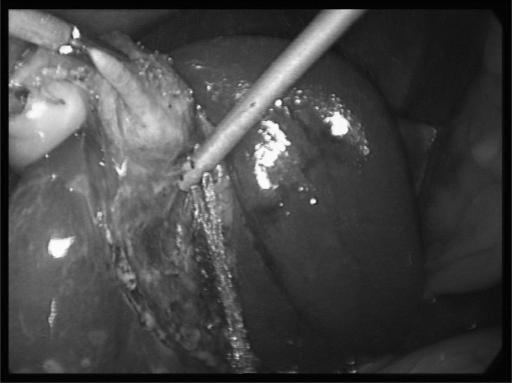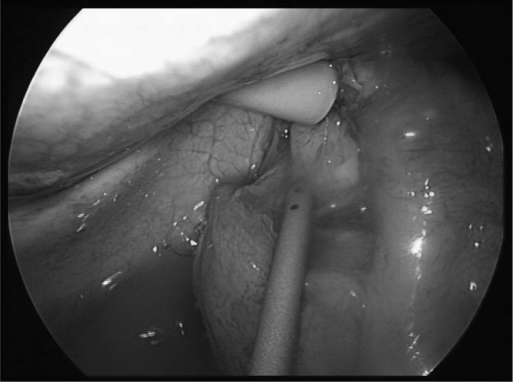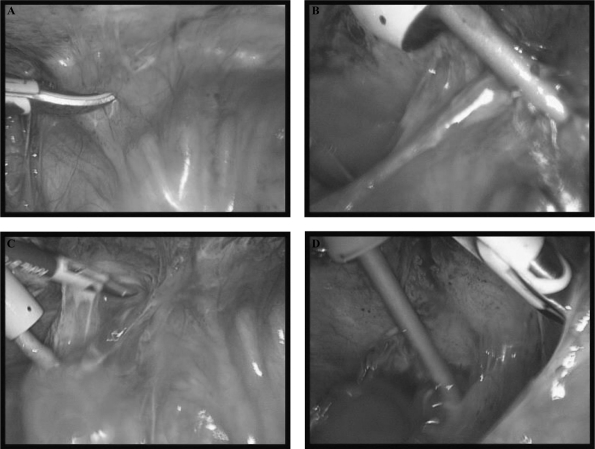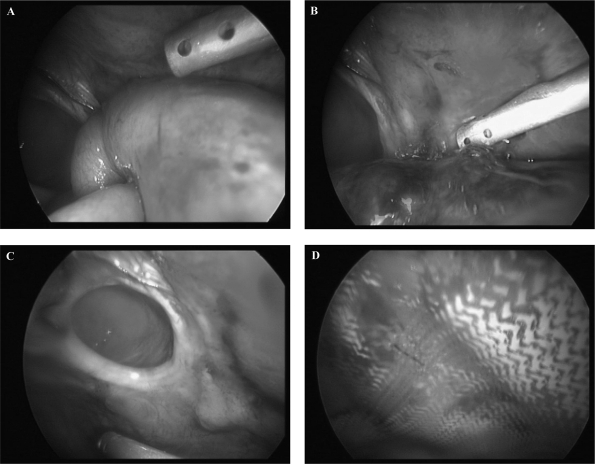A readily available, low-cost technology is described to assist in dissecting difficult tissue planes.
Keywords: Hydro-dissection, Saline-jet dissection, Hydro-jet dissection, Hernia, Cholecystectomy, Laparoscopy
Abstract
Introduction:
Single-stream hydro-jet dissection is increasingly used in various laparoscopic procedures, but its use requires special equipment. We describe a simple method for using an irrigation system for saline-jet tissue dissection as a useful adjunct prior to adhesiolysis.
Material and Methods:
Intraabdominal adhesions prolong laparoscopic procedures, because tissue planes are difficult to identify. We performed multi-jet saline dissection (MSSJ) between 2000 and 2009 in more than 500 patients during laparoscopy involving hernias, gallbladders, appendices, and intestinal obstructions. We use a standard suction irrigation probe, which is attached to a 1-liter saline bag with an inflatable cuff around to create a pressure of 250mm Hg to 300mm Hg. In effect, this is the standard setup generally used for irrigation. After using saline dissection, tissue planes can be better defined and the structures can then be separated.
Result and Discussion:
Using this method, we have successfully identified tissue planes in spite of dense adhesions, and our conversion rates to open have been reduced dramatically. This method is relatively safer than other modalities of tissue dissection, such as diathermy, ultrasonic, blunt or sharp dissection. The disadvantage is that with tissues saturated with saline it becomes more difficult to use diathermy hemostasis. Care has to be exercised in monitoring the temperature and volume of the fluid used.
INTRODUCTION
Intraabdominal adhesions prolong laparoscopic procedures because tissue planes are difficult to identify. Water stream under high pressure (Hydro-Jet) has been used to facilitate tissue dissection and release adhesions in laparoscopic surgery in the removal of gallbladders, kidneys, liver, spleen, and retroperitoneal lymph nodes.1–4 Often it is performed with a special single-steam hydro-jet generator.5 Hydro-Jet dissection is a useful tool in difficult operations that helps to identify natural bloodless tissue planes.6 Dissection using water under high pressure is relatively less traumatic to tissues7,8 and at the same time, provides excellent clarity of tissue planes. Use of hydro-jet dissection in laparoscopic hernia repair is not well documented and is uncommon. We have used a simple suction-irrigation system, as commonly used in laparoscopic cholecystectomy, in various laparoscopic procedures to define the fascial planes. This article is written to share our own experience in the use of multi-stream saline dissection in laparoscopic surgery and provides a low-cost version of the Cabot, Niagara, or Dorsy-Nezhat pumps.9,10
MATERIALS AND METHODS
We performed multi-jet saline dissection (MSSJ) between the years 2000 and 2009 in 500 patients during laparoscopy involving hernias, gallbladders, appendices, and intestinal obstructions. It includes 400 cases of laparoscopic cholecystectomy, 10 cases of laparoscopic appendicectomies, 30 cases of inguinal/incisional hernias, 57 cases of diagnostic laparoscopies including lymph node biopsies, and 3 cases of intestinal obstructions.
Multi-Stream Saline-Jet Dissection (MSSJ) -Novel Method
We used one standard suction irrigation probe (5 mm × 32 cm) (Core dynamics, Conmed, Utica, NY 13502, USA), which was attached to a 1-liter saline bag (Figure 1) prewarmed to 37°C with an inflatable cuff around to create a pressure of 250 mm Hg to 300mm Hg. In effect, this is the standard setup generally used for irrigation in all our cases.
Figure 1.
MSSJ bag under pressure and irrigation catheter.
The authors prefer to use a periumbilical 10-mm port and an angled telescope with a 30-degree or 45-degree lens. The location of remaining ports follows the rules of triangulation according to the procedure. After creation of the pneumoperitoneum, we use a standard suction irrigation probe attached to a 1-liter saline bag with an inflatable cuff around it to create a pressure of 250 mm Hg to 300 mm Hg.
In our series, we assessed the outcomes in terms of complications, patient comfort, feeling of surgical trainees and surgeons, and patient safety.
Laparoscopic Cholecystectomy
In bulky and adherent gallbladder mesenteries, after making an incision in the visceral peritoneum as near to Hartmann's pouch as possible, MSSJ has allowed better definition of tissue planes. The system has helped us define the anatomy of Calot's triangle (Figure 2) and dissect the gall bladder off its bed (Figure 3). Should the components of Calot's triangle not be clearly defined, staying close to the gallbladder end and creating a window between the gallbladder and the liver, with the help of the MSSJ, has allowed the introduction of an endostapler to perform subtotal cholecystectomy.
Figure 2.
MSSJ dissection during the dissection of triangle of Calot.
Figure 3.
MSSJ dissection during gallbladder bed dissection.
Laparoscopic Appendectomy
We have found MSSJ useful in difficult cases where the appendix is in subhepatic (Figure 4) or retrocecal positions. The appendix is held at the tip with endo-Babcock forceps, and saline stream under pressure is used to create water logging of the tissues. The irrigation system probe is used to apply countertraction at the appendicular mesentery. Then appendix is skeletonized by using bipolar or tripolar diathermy.
Figure 4.
MSSJ dissection during subhepatic appendectomy.
Laparoscopic Inguinal Hernia Repair
MSSJ dissection will be very useful when adhesions from previous operations or previous peritonitis are present, preventing the definition of a clear preperitoneal layer. We have used MSSJ successfully in cases of difficult TAPP inguinal hernias with adhesions. The water logging effect interferes with diathermy use due to poorer conductivity, and we therefore, do not routinely use it.
Laparoscopic Incisional and Paraumbilical Hernia Repairs
In incisional hernia, small bowel may be adherent to the anterior abdominal wall without identifiable tissue planes (Figure 5A). Tissue planes can be defined after using MSSJ (Figures 5B-D). Figure 6 shows another illustration of a recurrent incisional hernia where hydrodissection was used. Nontoothed endo forceps and scissors are used in addition to define the tissue planes bluntly. Using bipolar diathermy scissors, after multi-jet stream dissection, the peritoneal flaps. The hernial sac is identified, dissected, and reduced before an appropriate size mesh is cut to overlap the defect. The periphery of the mesh was fixed using tacks (Protack). The mesh is reperitonealized with peritoneal flaps.
Figure 5.
Massive adhesions between intestines and anterior abdominal wall at the site of an incisional hernia (A). MSSJ using a saline bag under pressure and standard laparoscopic irrigation-suction system (B). MSSJ leading to visualization of clear tissue planes (C). MSSJ leading to progression of tissue dissection (D).
Figure 6.
Hydrodissection to free up the bowel from peritoneum in a case of recurrent midline incisional hernia before hydrodissection (A), during hydrodissection (B), after Hydrodissection (C), and after mesh fixation (D).
RESULTS
MSSJ has 2 roles in cholecystectomy, which are defining Calot's triangle and removing the gallbladder off its bed. The tip of the MSSJ catheter can cause minor laceration, especially if it is kept in the wrong planes (against the liver). It occurred in 10 patients. None of them required any special intervention other than either diathermy or drains. Fat laden mesenteries separate easily with MSSJ. In some extreme cases of recurrent cholecystitis, there will be too dense adhesion and there are no separable planes. Ten such cases required subtotal cholecystectomy with an endostapler. While removing gallbladder off its bed, MSSJ may help to define a plane. In many cases, the hydrodissection was combined with the Spaghetti method to facilitate gallbladder removal from its bed.11 In our series, the bile spillage rate was around 10%. Forty of 400 patients developed spillage. This is because the gallbladders were very adherent to the gallbladder bed with no tissue planes.
Our MSSJ experience in laparoscopic appendectomy is limited and is only required in rare cases. We have used MSSJ in subhepatic, retrocecal appendices and in cases of appendicular masses where MSSJ helped us to complete the appendectomy laparoscopically. The only problem we encountered was bleeding because of adherent appendix rather than due to MSSJ. We have not come across any pelvic sepsis, because we always aspirate the peritoneal cavity dry at the end of the procedure. Routine MSSJ is not necessary in laparoscopic appendectomy but a useful adjunct to aid dissection.
Diagnostic laparoscopy has been performed for various types of abdominal pain. Hydrodissection has been used to identify tissue planes where there are adhesions. We have frequently encountered small amounts of bleeding, although it has never been a major problem.
The authors found MSSJ to be extremely useful in difficult hernia repairs particularly where there are adhesions. In our series, we identified one patient with bowel perforation from hydrodissection of a dense adhesion in an incisional hernia. The pain after hydrodissection is not very different from pain after nonhydrodissection hernia repairs. However, this method seems to be relatively safer than other modalities of tissue dissection, such as diathermy or ultrasonic dissection. Care should be taken to monitor the temperature and volume of fluid used. This is a low-cost, low-technology adjunct, accessible to all laparoscopic surgeons without recourse to expensive equipment.
DISCUSSION
Only blunt and sharp dissections have been described in the dissection of laparoscopic procedures. Use of aggressive dissection can cause hematomata. Hydrojet has been used during laparoscopy for more than 20 years.12 Hydro-Jet dissection requires a special hydro-jet generator13,14 and produces a high-pressure jet of between 20 to 60 BAR. The “original” hydro-jet systems forced the irrigant through a central cannula, and other methods also used an irrigation probe with a hypodermic needle type of tip. However, we have used a simple, readily available, inflatable cuff around a saline bag to create the MSSJ used in dissection. The saline under pressure functions less like a knife15 than like a gentle blunt dissector. Theoretically, it may spread cancer cells.16 Hydro-Jet technology produces a very thin water jet, acting almost like a cutting knife that is also very precisely directed with damage to vessels occurring when pressure reaches 60 BAR. On the contrary, we use a standard suction-irrigation probe that has quite large holes for the water/saline producing pressure between 1 to 1.5 BAR. Also, in a standard probe, the jet of water/saline is directed all around the probe. It means the effect of the dissection is mainly from water logging, and the single stream knife effect is dampened by the multistream, which may at least theoretically reduce the damage to hollow viscera. Our experience with MSSJ shows that the hernial sac can be defined in a less traumatic fashion. With less tissue dissection, one may expect reduced postoperative pain. Hydrodissection reduces damage to bile ducts by defining the anatomy better.17
Hydrodissection is another form of saline/water tissue dissection where a one off fixed amount of saline/adrenaline solution is injected into adherent tissues to create water logging, leading to separation of tissues along bloodless natural planes.18,19 The disadvantages are that there is no pressure or jet and the flow is not continuous.
In MSSJ, we use physiological normal saline that is readily available and inexpensive. It cleanses body systems, dilutes any blood, encourages hemostasis, and is readily absorbed. Dissection is faster, because one can visualize anatomical bloodless tissue planes more readily. Identification of such bloodless tissue planes is vital in laparoscopic hernia repair to prevent the development of hematomas. The pressure used can be readily adjusted by varying the bag pressure. The MSSJ dissection per se is not hemostatic. Theoretically, it may dislodge any clots and therefore encourage bleeding, but this does not happen in practice because it helps the surgeon to locate any bleeding vessel so that it can be diathermized.20 Using cold saline in large amounts can lead to hypothermia, so we use warmed fluids. Large amounts of saline in the tissues can lead to fluid overload, which should be borne in mind particularly if the patient suffers from heart or kidney failure. At the end of the procedure, we suck the peritoneal cavity dry to avoid development of complications related to saline, such as fluid overload and sepsis. We always use warm blankets and a warmer as standard for laparoscopic procedures, and therefore have not encountered any problems related to hypothermia.
CONCLUSION
MSSJ is a very useful adjunct technique in laparoscopic incisional hernia repairs, recurrent surgery, difficult gallbladders, cases where the anatomy is not clear because of excess fat and adhesions. This simple, low-cost technique, accessible to all, should be considered whenever a difficult situation arises because of adhesions, and there is a lack of a dissecting plane. Further large-scale studies are required, and a randomized controlled trial is necessary to confirm these findings.
Contributor Information
Rajaraman Durai, Minimally Invasive Surgery Unit, Department of Surgery, University Hospital Lewisham, London, United Kingdom..
Philip CH Ng, Minimally Invasive Surgery Unit, Department of Surgery, University Hospital Lewisham, London, United Kingdom..
References:
- 1. Rau HG, Buttler E, Meyer G, Schardey HM, Schildberg FW. Laparoscopic liver resection compared with conventional partial hepatectomy-a prospective analysis. Hepatogastroenterology. 1998;45(24):2333–2338 [PubMed] [Google Scholar]
- 2. Shekarriz B, Shekarriz H, Upadhyay J, Wood DP, Jr., Bruch HP. Hydro-jet dissection for laparoscopic nephrectomy: a new technique. Urology. 1999;54(6):964–967 [DOI] [PubMed] [Google Scholar]
- 3. Shekarriz B. Hydro-Jet technology in urologic surgery. Expert Rev Med Devices. 2005;2(3):287–291 [DOI] [PubMed] [Google Scholar]
- 4. Nissen NN, Grewal N, Lee J, Nawabi A, Korman J. Completely laparoscopic nonanatomic hepatic resection using saline-cooled cautery and hydrodissection. Am Surg. 2007;73(10):987–990 [PubMed] [Google Scholar]
- 5. Nezhat C, Nezhat FR. Safe laser endoscopic excision or vaporization of peritoneal endometriosis. Fertil Steril. 1989;52(1):149–151 [DOI] [PubMed] [Google Scholar]
- 6. Dorsey JH. Indications and general techniques for lasers in advanced operative laparoscopy. Obstet Gynecol Clin North Am. 1991;18(3):555–567 [PubMed] [Google Scholar]
- 7. Shimi SM. Dissection techniques in laparoscopic surgery: a review. J R Coll Surg Edinb. 1995;40(4):249–259 [PubMed] [Google Scholar]
- 8. Schurr MO, Wehrmann M, Kunert W, et al. Histologic effects of different technologies for dissection in endoscopic surgery: Nd:YAG laser, high frequency and water-jet. Endosc Surg Allied Technol. 1994;2(3–4):195–201 [PubMed] [Google Scholar]
- 9. Nezhat F, Nezhat C, Levy JS. Laparoscopic treatment of symptomatic diaphragmatic endometriosis: a case report. Fertil Steril. 1992;58(3):614–616 [DOI] [PubMed] [Google Scholar]
- 10. Schob OM, Schlumpf RB, Uhlschmid GK, Rausis C, Spiess M, Largiader F. The multimodal water jet dissector-a technology for laparoscopic liver surgery. Endosc Surg Allied Technol. 1994;2(6):311–314 [PubMed] [Google Scholar]
- 11. Durai R, Ng PC. “Spaghetti Technique”-novel technique to facilitate laparoscopic appendectomy and cholecystectomy. J Laparoendosc Adv Surg Tech A. 2009. October;19(5):667–668 [DOI] [PubMed] [Google Scholar]
- 12. Reich H. Laparoscopic treatment of extensive pelvic adhesions, including hydrosalpinx. J Reprod Med. 1987;32(10):736–742 [PubMed] [Google Scholar]
- 13. Park AE, Mastrangelo MJ, Jr., Gandsas A, Chu U, Quick NE. Laparoscopic dissecting instruments. Semin Laparosc Surg. 2001;8(1):42–52 [PubMed] [Google Scholar]
- 14. Corvin S, Sturm W, Schlatter E, Anastasiadis A, Kuczyk M, Stenzl A. Laparoscopic retroperitoneal lymph-node dissection with the waterjet is technically feasible and safe in testis-cancer patient. J Endourol. 2005;19(7):823–826 [DOI] [PubMed] [Google Scholar]
- 15. Shekarriz H, Shekarriz B, Upadhyay J, Burk C, Wood DP, Jr., Bruch HP. Hydro-jet assisted laparoscopic partial nephrectomy: initial experience in a porcine model. J Urol. 2000;163(3):1005–1008 [PubMed] [Google Scholar]
- 16. Cuschieri A. Experimental evaluation of water-jet dissection in endoscopic surgery. Endosc Surg Allied Technol. 1994;2(3–4):202–204 [PubMed] [Google Scholar]
- 17. Singh K, Ohri A. Anatomic landmarks: their usefulness in safe laparoscopic cholecystectomy. Surg Endosc. 2006;20(11):1754 –1758 [DOI] [PubMed] [Google Scholar]
- 18. Caliskan K, Nursal TZ, Yildirim S, et al. Hydrodissection with adrenaline-lidocaine-saline solution in laparoscopic cholecystectomy. Langenbecks Arch Surg. 2006;391(4):359–363 [DOI] [PubMed] [Google Scholar]
- 19. Naude GP, Morris E, Bongard FS. Laparoscopic cholecystectomy facilitated by hydrodissection. J Laparoendosc Adv Surg Tech A. 1998;8(4):215–218 [DOI] [PubMed] [Google Scholar]
- 20. Burke RK. Bipolar electrocautery is a vital component of an efficient, integrated hydro-dissection system. Endosc Surg Allied Technol. 1993;1(2):107–109 [PubMed] [Google Scholar]



